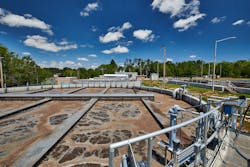Riviera Utilities Wastewater Treatment Facility
Cost: $18 million
Location: Foley, Alabama
Year: 2021-12-21
Size: 3.5 mgd design capacity with a primary peak of 10 mgd; 6 mgd secondary/tertiary peak
Owner: Riviera Utilities
Designers: Goodwyn Mills Cawood
Day Structures
Contractor: Max Foote Construction
The city of Foley, Alabama’s rapid economic growth combined with tightening of regulations for nutrient limits in surface waters, added strain on the Riviera Utilities Wastewater Treatment Facility (RUWWTF) treatment effectiveness and capacity.
These challenges prompted the owner and operator of RUWWTF, Riviera Utilities, to develop a team to plan, design and implement upgrades to the facility. Goodwyn Mills Cawood (GMC) was selected as its consulting partner.
The receiving stream, Wolf Creek, discharges into Wolf Bay, which is classified as an Alabama Outstanding Waterway. This classification indicates significant probability that nutrient limitations will be imposed. Additionally, space was at a premium and maintaining operations during the upgrade was a must.
AquaNereda aerobic granular sludge (AGS) technology was selected as the basis of design with its ability to produce the same effluent quality as an enhanced biological nutrient removal facility, while consuming significantly less real estate and energy. The AGS system replaced the extended aeration oxidation ditch process and allowed room for future expansion without the acquisition of new space.
“The biological process; I think that’s what makes the project such a stand out project. The fact that it is the first implementation in the U.S.,” said Denise King, project manager for the Riviera Utilities project.
The AGS process included three AGS reactors with a total treatment capacity of 3.5 mgd on a max monthly flow basis. The reactors have the capability to pass a total peak day flow of 6 mgd. The process operates similar to a sequencing batch reactor (SBR) and utilizes aerobic granules to treat waste. Instead of typical five-step SBR treatment cycles, the AquaNereda process has a three-step cycle: simultaneous feed and discharge, aeration, and then settling. The process cycles are staggered for each reactor, allowing one reactor to always be in the fill stage, so pre- or post-equalization tanks are not needed. This process allow for biological oxygen demand (BOD) removal, nitrification, denitrification, and phosphorus removal simultaneously in a single tank with higher MLSS concentrations.
The project consisted of a new influent pump station and headworks, complete with 6 mm rotary drum screens and mechanical vortex grit removal; a three-basin AGS system; tertiary filtration; sludge thickening; a plant reuse water pump station with a 9,000-gallon hydro-pneumatic tank; and a septage receiving station.
The facility utilizes the existing oxidation ditch tankage and clarifier as offline equalization. Two existing small clarifiers were converted into aerated sludge thickening prior to dewatering utilizing screw presses technology. In addition to the process equipment, three electrical buildings were constructed to house motor control centers, SCADA panels and other various equipment.
Maintaining existing process operations during construction proved to be challenging as well, as was the large amount of fine sand and grit that entered the collection system where it is conveyed to the treatment facility in coastal areas.
The process necessitates at least 95% removal of all grit and organic material greater than or equal to 105 microns. The peak capacity is 10 mgd and the headworks was designed to achieve this requirement with the installation of two 3 mm mechanical drum screens with a single screenings washer/compactor and conveyor, as well as a vortex grit removal system consisting of one PISTA 360 with V-Force Baffle, one PISTA TURBO Grit Washer, and one PISTA Grit Concentrator.
By the summer of 2020, the wastewater treatment facility had been upgraded to accommodate growth in the area. The construction sequence included three phases to allow for the continued processing of wastewater and discharge into the receiving stream. The process has simultaneously reduced power consumption at the facility by approximately 40% and expanded capacity.
After the construction completion, the AquaNereda reactors at the facility were seeded with standard flocculant activated sludge from the facility’s existing oxidation ditches while raw influent was gradually directed to the AGS reactors. Small granules, up to 600 µm in diameter, were observed within four weeks after seeding. The AGS reactors achieved adequate treatment performance, even without mature granules, which further prove the project’s success.
Project Year: 2021-12-21Contractor: Max Foote ConstructionDesigners: Goodwyn Mills Cawood Day StructuresOwner: Riviera UtilitiesLocation: Foley, AlabamaCost: $18 millionSize: 3.5 mgd design capacity with a primary peak of 10 mgd; 6 mgd secondary/tertiary peak